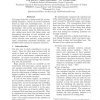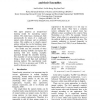COLING
2002
13 years 11 months ago
2002
Most current sentence alignment approaches adopt sentence length and cognate as the alignment features; and they are mostly trained and tested in the documents with the same style...
COLING
2002
13 years 11 months ago
2002
We propose a formal characterization of variation in the syntactic realization of semantic arguments, using hierarchies of syntactic relations and thematic roles, and a mechanism ...
COLING
2002
13 years 11 months ago
2002
I present a novel approach to the determination of recurrent sound correspondences in bilingual wordlists. The idea is to relate correspondences between sounds in wordlists to tra...
COLING
2002
13 years 11 months ago
2002
Automatic text categorization is a problem of automatically assigning text documents to predefined categories. In order to classify text documents, we must extract good features f...
COLING
2002
13 years 11 months ago
2002
We describe a parser for robust and flexible interpretation of user utterances in a multi-modal system for web search in newspaper databases. Users can speak or type, and they can...
COLING
2002
13 years 11 months ago
2002
This paper describes a dialog based QA system, Dialog Navigator, which can answer questions based on large text knowledge base. In real world QA systems, vagueness of questions is...
COLING
2002
13 years 11 months ago
2002
We describe a language-independent, flexible, and accurate method for the detection of abbreviations in text corpora. It is based on the idea that an abbreviation can be viewed as...
COLING
2002
13 years 11 months ago
2002
This paper proposes an unsupervised learning model for classifying named entities. This model uses a training set, built automatically by means of a small-scale named entity dicti...
COLING
2002
13 years 11 months ago
2002
We present a comparative evaluation of two data-driven models used in translation selection of English-Korean machine translation. Latent semantic analysis(LSA) and probabilistic ...
COLING
2002
13 years 11 months ago
2002
We present a novel disambiguation method for unification-based grammars (UBGs). In contrast to other methods, our approach obviates the need for probability models on the UBG side...


